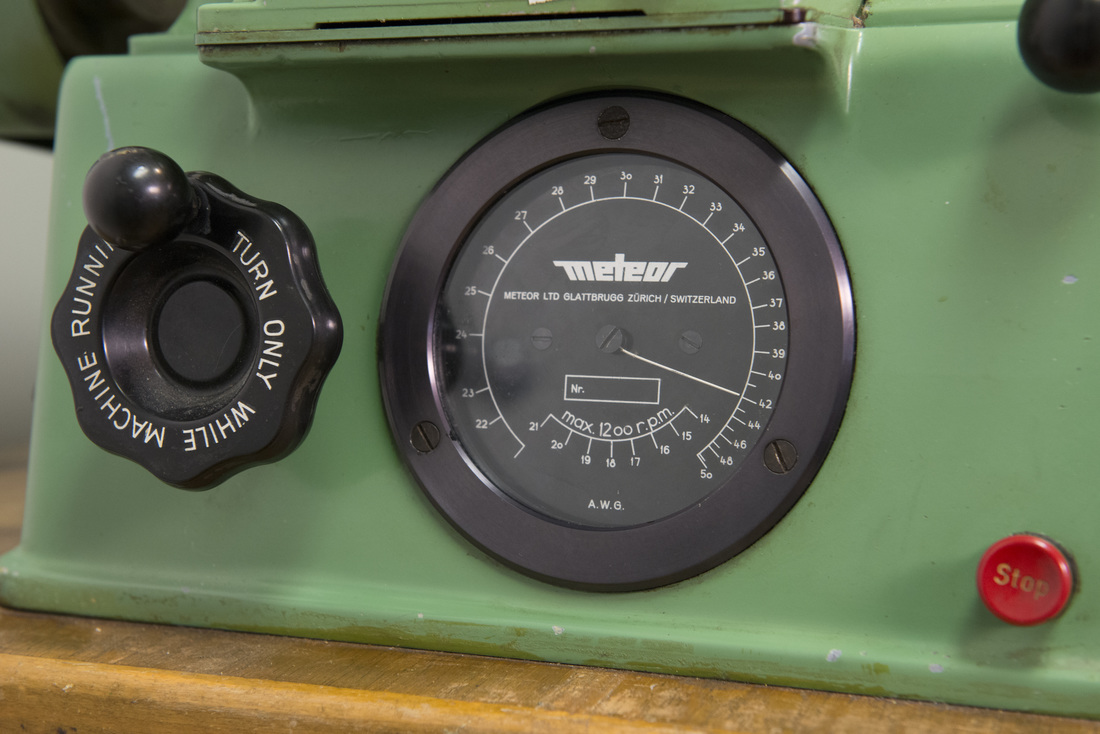ThroBak Meteor ME-301 Vintage Guitar Pickup Winder
ThroBak PAF electric guitar pickup reproductions wound on the Slug-101 pickup winder:
ME-301 Tonal Summary:
Due to the combination of low tension, 35% lower than optimal turn per layer and very accurate traverse, comparable to a lobed cam, the ME-301 produces accurately wound coils with little scatter that are fuller than a coil wound on the Leesona 102. It is a combination different than the other PAF winders. Tonally it makes for a slightly warmer low end than a pickup wound on the Leesona 102.
Due to the combination of low tension, 35% lower than optimal turn per layer and very accurate traverse, comparable to a lobed cam, the ME-301 produces accurately wound coils with little scatter that are fuller than a coil wound on the Leesona 102. It is a combination different than the other PAF winders. Tonally it makes for a slightly warmer low end than a pickup wound on the Leesona 102.

The Meteor 301 (ME-301): The most efficient PAF pickup winder.
Although the ME-301 design dates back to the 1950’s they are still in use as humbucker pickup winders at Gibson. However Gibson has since removed the old 50’s era Meteor wire guides to pack even more bobbins on these machines. So why keep the ME-301’s? One simple reason, efficiency. A Swiss made machine, it is full of innovations that speed it’s operation. The ME-301 is today commonly found in use and for sale due to its popularity. One benefit of the ME-301 is the quick change chuck system that allows for fast fixture swaps for different pickup models.
But beyond efficiency, what is the important distinction of the ME-301 when it comes to winding PAF coils? The ME-301 is different in that it adjusts turn per layer by means of a large dial by which you set the wire gauge. So for a PAF coil you simply turn the crank until the needle on the dial points to 42awg wire and the turn per layer is automatically set to the most efficient turn per layer for 42 awg wire. But not so fast! As it turns out the 42awg setting for the ME-301 is 35% lower than optimal for 42awg and all ME-301’s are off by this 35%. Why are they all this way? I have no idea, but they are. One further wrinkle is if the machine is adjusted improperly the “friction disk” that controls the turn per layer will prematurely wear causing as much as an additional 15% difference from the optimal turn per layer.
Although the ME-301 design dates back to the 1950’s they are still in use as humbucker pickup winders at Gibson. However Gibson has since removed the old 50’s era Meteor wire guides to pack even more bobbins on these machines. So why keep the ME-301’s? One simple reason, efficiency. A Swiss made machine, it is full of innovations that speed it’s operation. The ME-301 is today commonly found in use and for sale due to its popularity. One benefit of the ME-301 is the quick change chuck system that allows for fast fixture swaps for different pickup models.
But beyond efficiency, what is the important distinction of the ME-301 when it comes to winding PAF coils? The ME-301 is different in that it adjusts turn per layer by means of a large dial by which you set the wire gauge. So for a PAF coil you simply turn the crank until the needle on the dial points to 42awg wire and the turn per layer is automatically set to the most efficient turn per layer for 42 awg wire. But not so fast! As it turns out the 42awg setting for the ME-301 is 35% lower than optimal for 42awg and all ME-301’s are off by this 35%. Why are they all this way? I have no idea, but they are. One further wrinkle is if the machine is adjusted improperly the “friction disk” that controls the turn per layer will prematurely wear causing as much as an additional 15% difference from the optimal turn per layer.
The difference in turn per layer makes coils wound with the ME-301 instantly identifiable when repairing a vintage pickup. These signature coils appear in vintage P90’s, PAF’s, mini humbuckers with ultimately Kalamazoo made T-Tops being exclusively wound with the ME-301. Conventional wisdom is the difference in turn per layer was by design but the reality is if you simply follow the instructions for the machine you get this distinct turn per layer. It’s simply a practical result of the machine, nothing more complicated than that.




